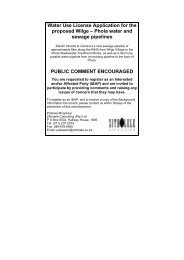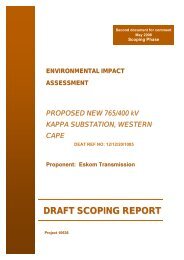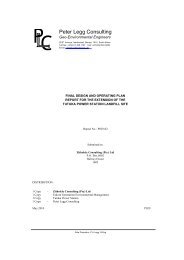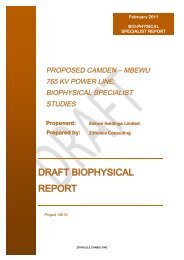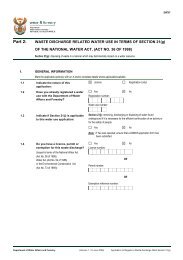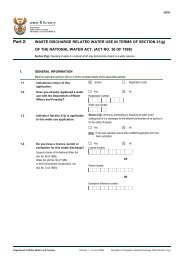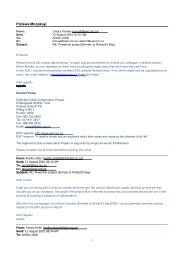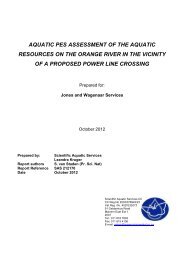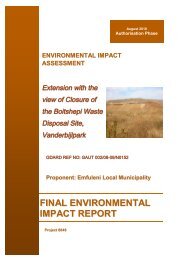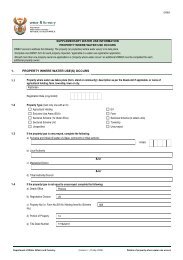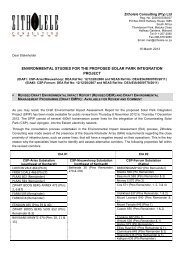Appendix I - Minutes from Public Meeting.pdf - Zitholele.co.za
Appendix I - Minutes from Public Meeting.pdf - Zitholele.co.za
Appendix I - Minutes from Public Meeting.pdf - Zitholele.co.za
Create successful ePaper yourself
Turn your PDF publications into a flip-book with our unique Google optimized e-Paper software.
Mr Thanyani <strong>co</strong>nfirmed that Louis Trichardt will also benefit and that Eskom is aware of theincreasing electricity demand in this town. He added that Eskom is aware of the problemsfaced in Louis Trichardt and that future projects are in the pipeline to address theseproblems. There is no additional transformation capacity at Tabor Substation. Theproposed project will add 500MVA of new transformation capacity which will not restrainload growth.2. Mr Otto asked when all these future developments will be <strong>co</strong>mpleted, because LouisTrichardt needs additional electricity as soon as possible. The town cannot expand andrecently lost out on two new factories, because electricity <strong>co</strong>uld not be guaranteed. Thismeans job losses for the people of Louis Trichardt. Mr Thanyani said <strong>co</strong>nstruction on theTabor project should start early next year if approval is granted. Other portions of theprojects to bring electricity to Louis Trichardt and the rest of the area north of Polokwaneinclude a 400 kV transmission line between the Witkop and Tabor Substations and a500MVA 400/132 kV transformer at Tabor by the end of 2012. Beyond 2015 a400 kVtransmission line between the Tabor and Nzhelele Substations will be <strong>co</strong>nstructed to caterfor the 20 year horizon. Eskom also has future plans for the area north of Polokwane withpossibly a new 400 kV line <strong>from</strong> the Lephalale generation pool to Nzhelele. This isdependent on the energy demand.3. Mr Otto <strong>co</strong>mmented that more electricity also means less people utilising wood forenergy.Mr Thanyani said it is agood <strong>co</strong>mment <strong>from</strong> an environmental and sustainability point ofview. It is <strong>co</strong>mmendable that participants support the <strong>co</strong>nstruction of the electricitytransmission infrastructure.4. Mr Joseph Mahlo (Department of Water Affairs -DWA) asked if any of these lines willreplace the lines to Polokwane.Mr Thanyani explained that lines to Polokwane will not be replaced; instead the new oneswill enhance the capacity and improve reliability of the network. The terminal points of theexisting lines at the Tabor Substation must be moved because they are in the way of theproposed expansion. The existing lines mentioned distribute electricity <strong>from</strong> the TaborSubstation to the surrounding areas such as Botlokwa.5. Ms Portia Munyai (DWA) asked if an application was made for aWater Use License. MsHex explained that was investigated right in the beginning of the process and ac<strong>co</strong>rding tothe relevant legislation it was not necessary to do so, because there is no impact on anywater bodies. Eskom will not place any of the pylon footings within water bodies or theirbuffer zone areas therefore not triggering Section 21 (c) or (i) of the National Water Act(1998).6. Mr Khathutshelo Ramukosi (Department of Agriculture) <strong>co</strong>mmented that his questionregarding any land claims against the property he asked at the previous meeting to discussthe Draft S<strong>co</strong>ping Report has been answered in the Report. Ms Hex <strong>co</strong>nfirmed any possibleland claims against the property has been investigated and no claims werefound.3
7. Mr Ramukosi asked for clarity regarding the deviation of the Tabor-Louis Trichardt 1powerline. Ms Hex explained it was necessary to move the existing Tabor-Louis Trichardt 1power line because it is in the footprint area of the proposed expansion of the Substation.Pylons have to be moved that are in the way of the proposed expansion (the number ofpylons is dependent on the approved alternative). Three alternatives have beeninvestigated ranging in length <strong>from</strong> 670 mto 1.7 km. The studies have shown that any ofthe three routes <strong>co</strong>uld be chosen by the authorising authority as all three alternatives havesimilarly low impact rankings. There was adiscussion on the three power line alternatives.The longest route being the most viable option <strong>from</strong> awater body and avi-fauna perspectiveas the existing 132kV power line (near to two dams) would be de<strong>co</strong>mmissioned therebylessening the avi-fauna impact, however the process of de<strong>co</strong>mmissioning the line wouldresult in impacts to the water body. Mr Thanyani <strong>co</strong>mmented that Eskom would, <strong>from</strong> afinancial perspective, prefer the shortest possible route to keep the <strong>co</strong>sts down. Ms Hexagreed as the shortest line also has the smallest footprint. After discussion of the variouspros and <strong>co</strong>ns for the three alternatives it was agreed by ALL present that Alternative 1, theshortest alternative, was the preferred alternative. Ms Hex explained that the final decisionwill be taken by the Department of Environmental Affairs (DEA) after all the relevantinformation and documentation has been studied.8. Mr Otto <strong>co</strong>mmented that the existing shorter route should be used, because the impact onthe environment is already there <strong>from</strong> the current line, even if the pylons are removed.9. Ms Munyai asked what will be done regarding ablution facilities for <strong>co</strong>nstruction workers.Ms Hex said existing facilities at the Tabor Substation will be used. Should there be aneedfor more facilities, portable ablution facilities will be rented. Additionally as stipulated in theEMP no pit latrines will be allowed.10. Ms Munyai asked if water will be needed during the <strong>co</strong>nstruction process. Ms Hex saidthere is wateravailable at the existing substation.11.Ms Munyai said any ha<strong>za</strong>rdous spills must be reported to the DWA. Ms Hex thanked MsMunyai for the request and said this will be written into the Environmental ManagementPlan.7. NEXT STEPSThe next step in the process would be for these <strong>co</strong>mments to be included in the FinalEnvironmental Impact Report which will be submitted to the DEA foradecision. The decision ofthe DEA will be announced to all stakeholders as soon as it is available.4
EIA PROCESSPresentation of DraftEnvironmentalImpactReport<strong>Public</strong> <strong>Meeting</strong>TaborSubstationProjectProposedupgrade /extensionof the Tabor Substation anddeviationof the Tabor-LouisTrichardt132kVpowerlineAgenda14:30 Registration15:00 Wel<strong>co</strong>me,introduction andobjectives15:10 <strong>Public</strong>participation15:25 Backgroundto project15:45 Questionsfor clarification16:00 PresentationonDEIR16:30 Discussionon DEIR17:00 Nextstepsandclosure22September 2010Wel<strong>co</strong>meand Introduction• Vuled<strong>za</strong>ni Thanyani-EskomWel<strong>co</strong>meand Introduction• Jacqui Hex-<strong>Zitholele</strong> ConsultingAndreJoubert• AndreJoubert-<strong>Zitholele</strong> Consulting1
Objectivesofthe <strong>Meeting</strong>Objectivesof the <strong>Meeting</strong>• Present the <strong>co</strong>ntents of the DraftEnvironmentalImpact Report and Draft EnvironmentalManagement Plan• Obtain<strong>co</strong>mments and inputs <strong>from</strong>stakeholderson the draft reports• Obtainsuggestions for the planning, impactassessment and public participationprocessesahead• Weare here to:SHARE informationOBTAIN<strong>co</strong>mmentsGuidelinesfor ProductiveDiscussion•Focus onissues, not people•Courtesy•One person at a time•Workthrough facilitator•Agreeto disagree•Cellphones onsilentAvailabilityof DEIR• Lodged, <strong>from</strong>30 August to23 September2010,at–Makhado <strong>Public</strong> Library–Polokwane City Library• Available on the Internet:– http://www.eskom.<strong>co</strong>.<strong>za</strong>/eia– http://www.zitholele.<strong>co</strong>.<strong>za</strong>/tabor• Available <strong>from</strong><strong>Zitholele</strong> Consulting2
Commenton DEIR• Captured at this <strong>Public</strong> <strong>Meeting</strong> (22 September2010) and on response forms• All <strong>co</strong>mments responded to in Issues andResponses Report• All <strong>co</strong>mments will be <strong>co</strong>nsidered in FinalEnvironmental Impact Report submitted to theDepartment of Environmental Affairs (DEA)<strong>Public</strong>ParticipationProcessAndreJoubert<strong>Public</strong>ParticipationProcess• It is aprocess in the Environmental ImpactAssessment(EIA) that is regulated underNEMA• It isto obtain and share informationand toverifythat <strong>co</strong>mments have been <strong>co</strong>nsideredv <strong>Public</strong>participationis:Aprocess leading to ajoint effort by stakeholders,technical specialists, the authorities and theapplicant who work together to produce betterdecisions than if they have acted independently<strong>Public</strong>ParticipationProcess<strong>Public</strong> participation process is designed toservethe followingobjectives:• Toprovide sufficient and accessibleinformation to stakeholders in an objectivemanner• Toassist in raising issues of <strong>co</strong>ncern andsuggestions for enhanced benefit• Toverify that their issues have beencaptured3
<strong>Public</strong>ParticipationProcess<strong>Public</strong>Participation:ExamplesMarch10Announcement of theEIAIssues and ResponseReport (1)Letter to announce project,BIDswith <strong>co</strong>mment/registration sheets,advertisements, sitenoticesApril10Draft S<strong>co</strong>ping Report andToRfor SpecialistStudies withIRRIssues and ResponseReport (2)Letter to announce publicreview ofDraft S<strong>co</strong>pingReport,public places andmeetingSubmit Final S<strong>co</strong>pingReport<strong>Public</strong>Participation:Adverts• Adverts were placed toannouncethe project (24-31 March 2010), for the DSR(26-30 April 2010) and for theDEIR(23–27 August 2010)<strong>Public</strong>Participation: ImpactAssessment PhaseFeedback to I&APsLetter announcing approvalandnext steps in theImpactAssessment–Capri<strong>co</strong>rnVoice–Informant–NorthernReview Weekend–Polokwane Express–Polokwane Observer–Seipone–Bosvelder–Vhembe Herald–Limpopo Mirror–ZoutpansbergerSept2010Oct2010<strong>Public</strong> Review ofDraft EIRIssues andResponse Report (3)Submit Final EIRLetter to announce thepublicreview,public places andreviewmeetingsCollate response to draftreportLetters and EnvironmentalAuthorisationnotification4
<strong>Public</strong>Participation: Documents foryour input• BID,follow-up letter and <strong>co</strong>mment/reply sheet• Draft S<strong>co</strong>ping Report (IRR Version 1)• Draft EIR (IRR Version 3) and EMP• Environmental AuthorisationOverviewof the ProposedProjectBrief background to projectEskomAgenda15:45 Questionsfor clarification16:00 PresentationonDEIR16:30 Discussionon DEIR17:00 Nextstepsand closureEnvironmentalImpactAssessmentProcessJacqui Hex5
Purposeofthe EIA process• Tosatisfy requirements of:–National Environmental Management Act–National Heritage Resources Act• Identify potential environmental impacts(social and biophysical) and determine theirlikely significance• Allow for public involvement• Inform Eskom’s decision-making• Inform Environmental Authority’s decisionþ February 2010þ March 2010þApril 2010þ June 2010September 2010October 2010èèèèInitial Application PhaseAuthority ReviewAuthority ReviewèApplicationformS<strong>co</strong>ping Report PhaseInitial public <strong>co</strong>nsultationDraft S<strong>co</strong>ping Report inc.Plan ofStudy for EIRFinal S<strong>co</strong>ping Reportinc.Planof Study for EIREIR PhaseDraft EIR &EMPFinal EIR &RevisedDraft EMPAuthority ReviewFebruary 2011Environmental AuthorisationèWearehereèOpportunity forAppealDraftEnvironmentalImpactReportJacqui HexPurposeofthe ImpactAssessmentPhase•Present the findings of the ImpactAssessment Phase in amanner thatfacilitates <strong>co</strong>mment<strong>from</strong>stakeholders anddecision-making by the relevantauthorities.•Basedon:–Literature review–Professional input (technicaland environmental)–<strong>Public</strong> input6
AlternativesRecapofAlternativesAlternative:‘apossible <strong>co</strong>urse of action, in place ofanother, that would meet the same purposeand need’• Activity alternatives–Dealt with through strategic policies/plans• Location alternatives–Substation extension–132kVpower line deviationRef: DEAT,2004Criteriafor assessingalternatives• Bio-physical <strong>co</strong>nstraints• Social<strong>co</strong>nstraints• Technical feasibility• Financial feasibilitySubstation• Thesubstation can onlybeextended to the northforthe following reasons:– Theexisting / currentlayoutof the substation is suchthat inorder for it to beextended only the northernportionis technicallyfeasible– Several planned futurepower lines willbeenteringthesubstation <strong>from</strong> thenorth7
LocationAlternativesin EIA132kVpower line alternatives• 670m –1.7 km deviation• 36m servitude (18m oneither side)• 200m <strong>co</strong>rridor assessed• Self supportingsuspension tower•Footprint300 x300metresSpecialistStudiesContextVisualAesthetics• Heritage• Visual• Terrestrialflora and fauna• Soils and land capability• Avi-fauna• Socialü Slightly to moderately undulating plainsü Somesmall scattered dams andpansoccur in thearea with no ridgesPotentialImpactü Construction may alter thevisualenvironmentü Thepresence ofan extendedsubstation may decrease quality ofthevisual environmentFindingsü Viewshed extends approximately5km - north6km -east2-3.5km –west4.5km -southü Static / Dynamic views8
VisualImpactMatrixPotentialObservationPointCategoryofPotentialReceptorContextofViewApproximate ViewDistancePeriodofViewFeatureVisibilitySignificanceViewshed extends approximately5km - north6km -east2-3.5km –west4.5km -southSurroundingStatic Level 1–5km Long Substation andFarmlandpowerlinesPetrolStation Static Level 2km Medium Substation andAlt2and 3PetrolStation Static Level 0.5km Long Powerlines(Alt1)GravelRoads Dynamic Above&below 0–5km Short Substation andPowerLinesMediumLowMediumLowTarRoads Dynamic Above&below 0–5km Medium Substation andAlt2and 3LowTarRoads Dynamic Above&below 0.5km Long Powerlines(Alt1)MediumVisualRe<strong>co</strong>mmendationsü Wherenew access roads are required,the disturbance areashouldbe kept as smallas possibleü Avoid the Alternative 1alignment,which ismuch more visiblethan the other two alignmentsü Locate access routes so as to limit modification to thetopography and to avoid the removal of established vegetationü If practically possible, locate <strong>co</strong>nstruction camps in areas thatare already disturbedü Utilizeexisting screening features such as dense vegetationstands or topographical features to place the <strong>co</strong>nstructioncamps and lay-down yards out of the view of sensitive visualreceptorsü Keep the <strong>co</strong>nstruction sites and camps neat, clean andorganized inorder to portray a tidy appearanceContextü Makhado Sweet Bushveldü Vegetationtype is poorly<strong>co</strong>nservedü 27 %transformed by cultivation withsomeurban and built upareasPotentialImpactü Vegetationclearingwill result inerosionwhich may <strong>co</strong>ntribute tosedimentationü Disturbedareas will be proneto alieninvasivespeciesRe<strong>co</strong>mmendationü Eskomvegetationmanagementguidelineü Demarcate<strong>co</strong>nstruction areas to limitimpactfootprintü Limitactivitiesto50 m<strong>from</strong>theedgeofthewater bodiesü Removealien invasive speciesü Search-and-RescueTerrestrialE<strong>co</strong>logy9
Contextü Maindrainage feature ofthearea istheunnamed stream which drainssouth westwards, several unnamedtributaries and damsü Species uniquely adapted to theseaquatic e<strong>co</strong>systemsPotentialImpactü Eroded materials may <strong>co</strong>ntribute tosedimentationü Crossing ofstreams and/orriverscan be destructive tosensitivehabitatsRe<strong>co</strong>mmendationü No specialist study proposed as nosurface water in direct footprintofalternativesü Re<strong>co</strong>mmendmitigation measuresSurfaceWaterSurfaceWaterMitigationMeasuresü Wastedemarcatedareasduringthe <strong>co</strong>nstructionphaseshouldbeprovided at the hard parkü Whenadequatevolumes(notmorethan 1month)have accumulatedallwasteis to be removed <strong>from</strong> site and disposedofatalicensedfacilityü Hydro-carbonsshouldbe storedin abundedstorageareaü Allha<strong>za</strong>rdousmaterialsmustbestored appropriatelyto preventthese<strong>co</strong>ntaminants<strong>from</strong>enteringthe environmentü Spill-sorborsimilartype productmustbe used to absorbhydrocarbonspillsin the event thatsuchspillsshouldoccurü Adequateerosionmeasureswhenremovingvegetationü No<strong>co</strong>nstructionvehiclesoractivitieswill be allowedto work within10mofany ofthe streamsorwetlandson site,unlessthiscannotbeavoided,then itshouldonlyoccurundersupervisionof the ECOü Demarcatethe“No-Go” areaswith tapeGroundwaterContextü Groundwaterisundisturbed-no mining/<strong>co</strong>nstructionactivitiescurrentlyunderwayü Maybe an impact<strong>from</strong> nearbyboreholesand sewageworksassociatedwiththe Garage and One-Stop to the north ofthe sitePotentialImpactü Spillage/leakage of hydrocarbons <strong>from</strong> heavy vehiclesorgenerators on siteü Contamination <strong>from</strong> pit latrines infiltrationFindings/Re<strong>co</strong>mmendationsü Placedgenerators in abunded area to capture all potentialspillagesü Nopit latrines should be allowedContextAvi-faunaü Habitat for sensitive species(rivers and dams) present instudy areaPotentialImpactü Destructionof habitats and therefore loss of sensitivespeciesü Collisions with power lines, pylons and steel structures atsubstationFindings /Re<strong>co</strong>mmendationü Installpower lines ac<strong>co</strong>rding tothe Eskom bird <strong>co</strong>llisionprevention guideline.ü Restrict<strong>co</strong>nstructionactivities to minimise habitatdestruction.10
HeritageResourcesContextü Graveyards and buildings over 60 years old may bepresentin the areaPotentialImpactü Destructionof heritage material during <strong>co</strong>nstructionü Vandalism of heritage material, through easier access tothesitesFindings /Re<strong>co</strong>mmendationü Constructionstaff to be made aware of the possibilityoftheoccurrence of sub-surface heritage features andprocedures to be followedContextü Area underlain by the gneisses andmigmatites oftheHout River Gneissü Sandstones and mudstones oftheMatlabas Subgroup are also foundü Soilsinclude deep, greyish sands,eutrophic plinthic catenas, red-yellowapedal freely drained soils with highbasestatus, clayey in bottom landsGeologyand SoilsPotentialImpactü Insufficient <strong>co</strong>ntrol measures during the<strong>co</strong>nstruction phase may result inerosion,<strong>co</strong>mpaction and sterilisation ofsoilresourcesü Reduction in landcapabilityü Poorsoil ameliorationmeasures mayresult in alack ofvegetationestablishmentSoils/Land Capabilityü Noblasting is undertaken on site without a suitableblastdesign,<strong>co</strong>mpiled in line with relevant SANS <strong>co</strong>des andapproved by an appropriately qualified professionalü Vehicles to keep toexisting roads as far as possibleü Nounnecessary vegetation must be removedü Ensurethat all machinery on siteis inagood workingorderü Rehabilitatedisturbed areas around pylons as soon aspractically possible after <strong>co</strong>nstruction.This should bedone to restrict extended periods of exposed soilü Ifsoils are excavated, ensure that the soil is utilisedelsewhereü Ensurethat soil is stockpiled in such a way as to preventerosion <strong>from</strong> storm water.LandUse /AgriculturalPotentialContextü Dominated bythicket andbushlandwhichispredominantlyutilisedforgame farms and cattlegrazingPotential Impactü Reductionin farm sizeü Safety of animals andworkersü Loss of grazingland11
AirQualityContextü General good existing ambient air qualityü Minimal exhaust fumes <strong>from</strong> N1ü Gravel roads -potential dustPotentialImpactü Dustand exhaust fumes <strong>from</strong> <strong>co</strong>nstruction vehiclesFindings/Re<strong>co</strong>mmendationsü Traffic <strong>co</strong>ntrol measures aimed at reducing theentrainment of material by restrictingtraffic volumesand reducing vehicle speedsü Measures aimed at binding thesurface material orenhancing moisture retention, suchas wetsuppressionand chemical stabili<strong>za</strong>tionSocialImpactContextü Lowdensity rural land uses with various farmingpractices inareaPotentialImpactü Negative perceptionsü Sense of placeü Influx of <strong>co</strong>nstructionworkers and job seekersü Safety and securityFindings/Re<strong>co</strong>mmendation• Inform localbusinessesaboutthe expectedinfluxof <strong>co</strong>nstructionworkerssothatthey canplan forthe extrademand• Ensurethatthe local<strong>co</strong>mmunity(Ga Phasha,Sekakene,Botlokwa)<strong>co</strong>mmunicatetheirexpectationsof<strong>co</strong>nstructionworkers’behaviourSocial<strong>co</strong>ntinued...ü Ensurethat employment procedures / policy are<strong>co</strong>mmunicated to local stakeholders through the WardCouncillors of the closest<strong>co</strong>mmunities (Ga Phasha,Sekakene,Botlokwa) and tothe local farmerü Have clear rules and regulations for access tothe<strong>co</strong>nstructioncamp to<strong>co</strong>ntrol loiteringü Consultwith local SAPS toestablishstandard operatingprocedures for the <strong>co</strong>ntrol and removal of loiterers at the<strong>co</strong>nstructionsiteü Constructionworkers should be clearly identifiable bywearing proper <strong>co</strong>nstructionuniforms displaying the logoofthe <strong>co</strong>nstruction<strong>co</strong>mpany. Constructionworkers mustalsobe provided with identification tagsNoiseContextü Existing impacts <strong>from</strong> N1 trafficPotentialImpactü Constructionvehicles and workers on siteusing heavymachineryü Maintenanceactivities during the operational phaseFindings/Re<strong>co</strong>mmendationsü Noise generating activities 7h00-17h00ü All heavy duty vehicles tobe fitted withexhaust silencersü All diesel powered earth moving and <strong>co</strong>nstructionequipment must be of high quality and well maintainedü Regular scheduled maintenance must includethecheckingand replacement, if necessary,of intake andexhaust silencers12
TrafficContextü Existing access road <strong>from</strong> the N1 toll road, just before thetollgate is currently utilised for maintenancePotentialImpactü Traffic volumes will increase as aresult of the presence of<strong>co</strong>nstructionvehiclesFindings/Re<strong>co</strong>mmendationsü All road design work must be carried out by suitablyqualified personnel, <strong>co</strong>mpliant with relevant standards andbe approved by the appropriate road authorityü All <strong>co</strong>nstructionvehicles will as far as possible be <strong>co</strong>nfinedtositeand will not travel on public roadsü The normal working day will be 07:30 to 17:30, Mondays toSaturdays, with work on Sundays only in exceptionalcircumstancesCONSTRUCTIONIMPACTS OPERATIONALIMPACTSPowerLinesPowerLinesEnvironmentalAspects SubstSubstAlt 1 Alt 2 Alt3 Alt 1 Alt 2 Alt 3VeryLowAir QualityLow(shortestVeryLowline)Aquatic E<strong>co</strong>logy NoImpact NoImpactVeryLow(willresultinVeryLow(willresultintheAvi-faunatheLowLowLowLowdeviationdeviatioaway <strong>from</strong>nawaythedams)<strong>from</strong>thedams)GeologyVery LowGroundwaterLowSoilsandAgriculturalLowPotentialSurfaceWaterandLow Moderate VeryLowWetlandsTerrestrialE<strong>co</strong>logy Low VeryLow LowTopography Very Low LowNoImpactHeritageVery LowNoiseSocialLowVeryLowTrafficVisual Moderate ModerateTOTALIMPACTS 24 22 24 23 17 17 18 18RANKING n/a 1 3 2 n/a 1 2 2DraftEnvironmentalManagementPlan• Includedin the EIR• Includesre<strong>co</strong>mmended mitigation andmanagement actions by Specialists• Before, during and after <strong>co</strong>nstruction• Line ‘walk downs’, prior to <strong>co</strong>nstruction to assistin <strong>co</strong>mpilation for Final EMP13
• Willinclude landowners’ specific <strong>co</strong>nditions• EMPwill form part of <strong>co</strong>nstruction <strong>co</strong>ntractors’<strong>co</strong>ntract• Environmental Control Officers (on-site andEskominternal) appointed tomonitoradherence toEMPGeneralDiscussionNext Steps• Comment periodfor Impact AssessmentPhaseends on23 September 2010Next StepsAndre Joubert• Finalise EIR and EMPand submit to the DEA(October 2010)• Decision on Environmental Authorisation(January /February 2011)14
Commentson DEIR• Send <strong>co</strong>mments to:–Anelle Lotter or Andre Joubert<strong>Zitholele</strong> ConsultingP. O. Box 6002, Halfway House, 1685Tel: (011) 2072076 / 2077 or 082-804-5890Fax: 086676 9950Email: alotter@zitholele.<strong>co</strong>.<strong>za</strong>andrej@zitholele.<strong>co</strong>.<strong>za</strong>• All <strong>co</strong>mments responded to in the Issues andResponse Report in Final EnvironmentalImpact ReportThankyou for your time15
9/28/2010Thenature of bulk electricitysupply2TRANSMISSIONSUBSTATIONSMUNICIPALITIES1TaborSubstationPOWERSTATIONSGENERATIONTRANSMISSION LINES3DISTRIBUTIONLINESDISTRIBUTIONDISTRIBUTIONSUBSTATIONSVuled<strong>za</strong>ni ThanyaniRETICULATIONHVLINE(22/11kV)SERVICECONNECTIONRETICULATION LV LINE(380/220V)GenerationTransmission1
9/28/2010DistributionCurrent Network2006PolokwanePretoriaJohannesburgUpingtonBloemfonteinDurbanEastLondonCapeTownPortEli<strong>za</strong>bethOverviewofTransmissionlinebuildingpractices2
9/28/2010Motivation of upgrade ofthe TaborSubstation• ThePolokwane area has experienced goode<strong>co</strong>nomic growth, due to urban growth,electrification, mining and industriali<strong>za</strong>tion• Eskomhas tosupport this growth in the Limpopobystrengthening the transmission network thatwill also add extra power supply options to theSouth African electricity gridCont…• A275kVTabor-Spencer and 400kVTabor-Witkoppower line have received environmentalauthorisation <strong>from</strong> the DEA in 2007 and 2008respectively• Inorder to integrate these additional lines intotheTabor Substation the substation needs to beupgraded and expanded to carry the increasedload of the new transmission power lineFuture PlansFuture WitkopTabor400kVlineTabor Nzhelele 400kvLineFuturePlans• -1xWitkopTabor 400kV line• -1x500MVA400/132kV transformer at Tabor• -1xTabor -Nzhelele 400kV line1x500MVA400/132kVtransformeratTabor3
9/28/2010Thankyou4
Environmental Impact Assessment for the proposed expansionof the Tabor substation and the deviation of the existing Tabor-Louis Trichardt 1power line (132 kV) north of Polokwane(DEA Ref No 12/12/20/1776)Re<strong>co</strong>rdof thepublic meetingheldat LalapanziHotelandConferenceCentrenearMakhadoon Thursday,13May 2010topresent theDraftS<strong>co</strong>pingReport toInterestedandAffectedPartiesPlease see <strong>Appendix</strong> Aforalist of the stakeholders who attended the meeting.1. INTRODUCTIONA public meeting was held on Thursday, 13 May 2010 at 15:00 at the Lalapanzi Hotel andConference Centre south of Makhado as part of the Environmental Impact Assessment (EIA)process to obtain environmental authorisation for the proposed expansion of the Tabor substationand the deviation of the existing Tabor-Louis Trichardt 1power line (132 kV) between Polokwaneand Makhado/Louis Trichardt.Notification of the meeting was sent to all stakeholders on the database and advertisements wereplaced in the Capri<strong>co</strong>rn Voice, Informant, Northern Review Weekend, Polokwane Express,Polokwane Observer, Seipone, Bosvelder, Vhembe Herald, Limpopo Mirror and theSoutpansberger during the last week of April 2010 to invite the public to the meeting to discuss theDraft S<strong>co</strong>ping Report.The meeting was attended by 16 stakeholders, which included Government representatives, threeEskom officials and two people <strong>from</strong> <strong>Zitholele</strong> Consulting.This document presents a summary report of the deliberations of the meeting. In addition theissues and <strong>co</strong>mments raised at the meeting are captured in an Issues and Responses Report. Thisreportcaptures the <strong>co</strong>ncerns and issues <strong>from</strong> stakeholders throughout the EIA.2. OBJECTIVES OFTHE MEETINGThe objectives of the meeting were to: Present to stakeholders the Draft S<strong>co</strong>ping Report (DSR) of this Environmental ImpactAssessment(EIA), which was available for publicreview <strong>from</strong> 30 April to 28 May 2010; Obtain <strong>co</strong>mments and inputs <strong>from</strong> stakeholders with regard to the DSR; and Obtain suggestions for the planning, impact assessment and public participation processesahead.1
3. BACKGROUND TO THE PROPOSED TABOR PROJECTMr Vuled<strong>za</strong>ni Thanyani, Eskom Project Manager explained why the expansion of the TaborSubstation was necessary and the vital role it will play in providing additional reliable electricity tothe northern region of South Africa.The Tabor Substation mustbe upgraded because:• The Polokwane area has experienced good e<strong>co</strong>nomic growth, due to urban growth,electrification, mining and industriali<strong>za</strong>tion;• Eskom has to support this growth in the Limpopo by strengthening the transmissionnetwork thatwill also add extra power supply options to the South African electricity grid;• The 275kV Tabor-Spencer and 400kV Tabor-Witkop power lines have receivedenvironmental authorisation <strong>from</strong> the Department of Environmental Affairs in 2007 and2008 respectively; and• In order to integrate these additional lines into the Tabor Substation it must be upgradedand expanded to carry the increased load of the new transmission power lines.4. ENVIRONMENTAL IMPACT ASSESSMENT AND AUTHORISATION PROCESSMs Jacqui Hex, <strong>Zitholele</strong> Consulting gave an overview of the EIA process and explained andpresented the <strong>co</strong>ntents of the DSR.The purpose of the DSR is to identify alternatives and potential impacts requiring more detailedinvestigationin the Environmental Impact Report phase. This is based on:• Literature review;• Professional input (technical and environmental); and• <strong>Public</strong> input.Potential impacts to be investigated during the EIA process are:• Visual;• Terrestrial flora and fauna;• Heritage resources;• Soils and land capability;• Avi-fauna; and• Society.5. PUBLIC PARTICIPATION PROCESSMr Joubert gave an overview of the public participation process that was followed to date and thenext steps to be followed in the process. He also highlighted the role of stakeholders and the valuethat they can <strong>co</strong>ntribute to aproject.Please see <strong>Appendix</strong> B forall the presentations delivered at the meeting.2
6. DISCUSSIONThe questions asked, responses provided and any other <strong>co</strong>mments made during the publicmeeting are summarised below:1. Ms Joyce Mashiteng (Eskom) asked that the proposed size of the expansion 300 metres X300 metres be explained to the meeting. Ms Hex said the area would be the size of threeschool football/rugby fields.2. Ms Olga Ligege (Department of Agriculture, Forestry and Fisheries - DAFF) said herDepartment uses a different list of protected plants than that of the Department ofEnvironmental Affairs. Ms Hex thanked Ms Ligege for this information and said this will betaken into <strong>co</strong>nsideration during the specialist studies and requested a<strong>co</strong>py of the list.3. Mr Modige Monakedi (Limpopo Department of Agriculture) asked what route the line to bedeviated will follow and how big the impact will be on the land. Ms Hex explained that theimpact is dependent on the deviation alternative.She explained that there are three <strong>co</strong>rridoralternatives that will be assessed for the proposed deviation. During the impact assessmentphase of the project the impacts of each of these alternatives on the environment (social,bio-physical and cultural) will be assessed and determined. This information will then bepresented in the Draft Environmental Impact Report and stakeholders will have anopportunity to <strong>co</strong>mment on these findings. Based on this information together withstakeholder <strong>co</strong>mments a preferred alternative will be presented to the Department ofEnvironmental Affairs for adecision.4. Mr Khathutshelo Ramukosi (Limpopo Department of Agriculture) asked if there are any landclaims against the land Eskom has earmarked for the expansion and should there be anyclaims, if the claimants would be <strong>co</strong>mpensated for their loss of land. Ms Mashiteng said thechances are small that there are any outstanding land claims against the land on which thesubstation is built upon, because Eskom already has aservitude on this property and it isregistered as such in the Surveyor-General’s office. However, Eskom will clarify if there areany land claims against the land needed for the expansion of the substation and will furtherinvestigate the matter.5. Mr Monakedi asked what is being done by Eskom to lessen the impact of power lines onpeople. Ms Mashiteng said studies undertaken during an EIA will <strong>co</strong>me up with aproposedroute with the lowest impact on the environment as well as people living in the affectedarea. After Environmental Authorisation has been granted, Eskom officials walk the entireroute of aproposed power line to negotiatethe exactposition of pylons with landowners. MrThanyani added that farmers can plant maize, wheat, etc underneath power lines andanimals can also graze there, but structures such as houses and buildings are notpermitted underneath power lines.3
6. Mr Monakedi said he is <strong>co</strong>ncerned about people who <strong>co</strong>uld be negatively affected, becausethere have been instances in the Limpopo where Eskom <strong>co</strong>nstructed power lines without<strong>co</strong>nsulting the affected people. People have also been moved without receiving any<strong>co</strong>mpensation. Ms Mashiteng said unfortunately some mistakes were made. Eskom isaware of the problems in the Burgersfort area and is in the process of rectifying thatmistake. The reason why this meeting is being held is to prevent mistakes like that. An EIAdone for Eskom will always be <strong>co</strong>nsultative and the public participation process is,therefore, very important.7. Mr Mfundi Songo (Eskom) said the expansion of the Tabor substation and otherdevelopments planned in the Limpopo are to the assist with the electrification of theprovince and reduce the electricity backlog in the province.7. NEXT STEPSThe next step in the process would be for these <strong>co</strong>mments to be included in the Final S<strong>co</strong>pingReport. The Final S<strong>co</strong>ping Report will then be submitted to the Department of EnvironmentalAffairs (DEA) for their review and approval.Participants were reminded that they all have the opportunity to <strong>co</strong>mment on the DSR until 28May 2010.Once the DEA has approved the report, the next phase of the project will <strong>co</strong>mmence, which isthe Impact Assessment Phase. In this phase, the specialist studies will be <strong>co</strong>nducted. Thefindings of the specialist studies will be in<strong>co</strong>rporated in the Draft Environmental Impact Report.Copies of the report will be made available to stakeholders for <strong>co</strong>mment and review.A meeting to present these findings is also being planned towards the end of 2010 andstakeholders will again be invited.4
EIAPROCESSPresentation of DraftS<strong>co</strong>ping Report<strong>Public</strong> <strong>Meeting</strong>TaborSubstation ProjectProposedupgrade /extension of the Tabor Substation andDeviationof the Tabor-Louis Trichardt132kVpowerlineAgenda14:30 Registration15:00 Wel<strong>co</strong>me,introduction andobjectives15:10 Backgroundto project15:30 Questions for clarification15:45 PresentationonDSR16:15 <strong>Public</strong> participation16:30 Discussionon DraftS<strong>co</strong>ping Report17:00 Nextstepsand closureMay 2010Wel<strong>co</strong>meand Introduction• Vuled<strong>za</strong>niThanyani -Eskom• JoyceMashiteng -EskomWel<strong>co</strong>meand IntroductionAndre Joubert• DuduHadebe -Eskom• MfundiSongo -Eskom• JacquiHex -<strong>Zitholele</strong>Consulting• AndreJoubert -<strong>Zitholele</strong>ConsultingObjectivesof the <strong>Meeting</strong>Objectivesof the <strong>Meeting</strong>• Present the <strong>co</strong>ntents of the DraftS<strong>co</strong>ping Report• Obtain<strong>co</strong>mments and inputs <strong>from</strong> stakeholderson the Draft S<strong>co</strong>ping Report• Obtainsuggestions for the planning, impactassessment and public participationprocessesahead• We are here to:SHAREinformationOBTAIN<strong>co</strong>mments1
Guidelinesfor ProductiveDiscussion• Focusonissues, not people• Courtesy• Onepersonat a time• Workthrough facilitator• Agreeto disagree• Cellphones onsilentOverviewof the ProposedProjectBrief background to projectEskomAgenda15:45 Presentationon DSR16:15 <strong>Public</strong> participation16:30 Discussionon DraftS<strong>co</strong>ping Report17:00 Nextstepsand closureEnvironmentalImpactAssessmentProcessJacqui HexPurposeofthe EIA process• Tosatisfy requirements of:– National Environmental Management Act– National Heritage Resources Act• Identify potential environmental impacts(social and biophysical) and determine theirlikely significance• Allow for public involvement• Inform Eskom’s decision-making• Inform Environmental Authority’s decisionFebruary 2010March2010April 2010June 2010September 2010November2010Initial Application PhaseApplicationformAuthority ReviewAuthority ReviewS<strong>co</strong>ping Report PhaseInitial public <strong>co</strong>nsultationDraftS<strong>co</strong>ping Reportinc.Plan ofStudy forEIRFinal S<strong>co</strong>ping Reportinc.Planof Study for EIREIR PhaseDraft EIR &EMPFinal EIR &RevisedDraft EMPAuthority ReviewMarch2011Environmental AuthorisationWearehereOpportunityfor Appeal2
Purposeof the S<strong>co</strong>pingPhaseDraftS<strong>co</strong>pingReportJacqui Hex• Identify alternatives and potential impactsrequiring moredetailed investigation intheEIRphase• Basedon:– Literature review– Professional input (technicaland environmental)– <strong>Public</strong> input• Formsbasis forPlanof Study forEIAAvailabilityofDSR• Lodged,<strong>from</strong> 30 April to 28 May 2010, at– Makhado <strong>Public</strong> Library– Polokwane City Library• Available on the Internet:– http://www.eskom.<strong>co</strong>.<strong>za</strong>/eia– http://www.zitholele.<strong>co</strong>.<strong>za</strong>/tabor• Available <strong>from</strong><strong>Zitholele</strong> ConsultingCommenton DSR• Captured at this<strong>Public</strong> <strong>Meeting</strong> (13 May2010)and on response forms• All<strong>co</strong>mments responded to in Issues andResponse Report• All<strong>co</strong>mments will be <strong>co</strong>nsidered in FinalS<strong>co</strong>ping Report submitted tothe Department ofEnvironmental Affairs (DEA)• DEAmay require additional changes to Plan ofStudyfor EIAAlternativesIdentificationof AlternativesAlternative:‘ apossible <strong>co</strong>urse of action, in place ofanother, that would meet the same purposeand need’Ref: DEAT, 20043
AlternativesCriteriafor assessingalternatives• Activity alternatives– Dealt with through strategic policies/plans• Location alternatives– Substation extension– 132kVpower line deviation• Bio-physical <strong>co</strong>nstraints• Social <strong>co</strong>nstraints• Technical feasibility• FinancialfeasibilitySubstation• The substation canonlybe extended tothe northfor the following reasons:LocationAlternativesin EIA– Theexisting /currentlayoutof thesubstation is suchthat in order for it to beextended only the northernportionis technicallyfeasible.– Several planned futurepower lines will be enteringthesubstation <strong>from</strong> thenorth.132kVpower line alternativesPotentialImpacts• Visual• Terrestrialflora and fauna• Heritage resources• Soils and land capability• Avi-fauna• Society4
ContextVisualAesthetics Slightly to moderately undulating plains Somesmall scattered dams and pansoccurinthearea with no ridgesPotentialImpact Constructionmay alter thevisualenvironment The presence ofaextended substationmaydecrease quality of the visualenvironmentRe<strong>co</strong>mmendation Visual impact assessment professionalopinionto be <strong>co</strong>nducted with<strong>co</strong>nsideration <strong>from</strong>arange ofreceptorpointsContext Makhado Sweet Bushveld Vegetationtype ispoorly<strong>co</strong>nserved 27 % transformed bycultivation withsomeurban and builtup areasPotentialImpact Vegetationclearingwill result inerosionwhich may <strong>co</strong>ntribute tosedimentation Disturbed areas willbe prone to alieninvasive speciesRe<strong>co</strong>mmendation Terrestrial e<strong>co</strong>logical impactassessment professional opinion Re<strong>co</strong>mmend mitigation measuresTerrestrialE<strong>co</strong>logyContext Maindrainage feature ofthe area istheunnamed stream which drainssouthwestwards, several unnamedtributaries and dams Speciesuniquely adapted to theseaquatic e<strong>co</strong>systemsPotentialImpact Erodedmaterials may <strong>co</strong>ntribute tosedimentation Crossing ofstreams and/or riverscanbe destructive tosensitivehabitatsRe<strong>co</strong>mmendation Nospecialist study proposed as nosurfacewater indirect footprintofalternatives Re<strong>co</strong>mmend mitigation measuresSurfaceWaterContextAvi-fauna Habitat for sensitive species (rivers and dams) present instudyareaPotentialImpact Destructionof habitatsand therefore loss of sensitivespecies Collisionswith power lines, pylons and steelstructuresatsubstationRe<strong>co</strong>mmendation An avi-fauna impact assessment on the alternative Re<strong>co</strong>mmend mitigation measuresHeritageResourcesContext Graveyards and buildings over 60 years old may bepresent in the areaPotentialImpact Destructionof heritage material during <strong>co</strong>nstruction Vandalism of heritage material, through easier access tothe sitesRe<strong>co</strong>mmendation Phase 1 Heritage AssessmentContext Areaunderlain bythe gneisses andmigmatites oftheHout River Gneiss Sandstones and mudstones oftheMatlabas Subgroupare also found Soilsinclude deep, greyish sands,eutrophic plinthic catenas, red-yellowapedalfreelydrained soils with highbasestatus, clayey inbottomlandsGeologyand SoilsPotentialImpact Insufficient <strong>co</strong>ntrol measures during the<strong>co</strong>nstruction phase may result inerosion,<strong>co</strong>mpaction and sterilisation ofsoilresources Reduction in landcapability Poorsoil ameliorationmeasures mayresult inalack ofvegetationestablishmentRe<strong>co</strong>mmendation Soilimpact assessmentonthe routes Re<strong>co</strong>mmend mitigation measures5
LandUse /AgriculturalPotentialContext Dominatedbythicketand bushlandwhichispredominantlyutilisedforgamefarmsand cattlegrazingPotentialImpact Reductioninfarm size Safetyof animalsandworkers Lossof grazing landRe<strong>co</strong>mmendation Re<strong>co</strong>mmendmitigationmeasuresSocialImpactContext Lowdensityrural land uses with Various farmingpracticesin areaPotential Impact Negative perceptions Sense of placeRe<strong>co</strong>mmendation Undertake aSocialImpact Assessment professionalopinion Re<strong>co</strong>mmend mitigation measures<strong>Public</strong>ParticipationProcess<strong>Public</strong>ParticipationProcessAndre Joubert• Itisaprocess in the EIAthat is regulatedunder NEMA• Itisto obtain andshare information and toverifythat <strong>co</strong>mmentshave been <strong>co</strong>nsidered <strong>Public</strong>participationis:Aprocessleadingto ajoint effortbystakeholders,technicalspecialists, theauthoritiesand the applicantwho worktogetherto producebetter decisionsthanifthey have acted independently<strong>Public</strong>ParticipationProcess<strong>Public</strong> participation process is designed toservethe followingobjectives:• Toprovide sufficient and accessibleinformation to stakeholders in an objectivemanner• Toassistin raising issues of <strong>co</strong>ncern andsuggestions for enhanced benefit• Toverify that their issues have been capturedMarch10April 10<strong>Public</strong>ParticipationProcessAnnouncement of theEIAIssues and ResponseReport (1)Draft S<strong>co</strong>ping ReportandToRfor SpecialistStudies withIRRIssues and ResponseReport (2)Letter to announce project,BIDswith <strong>co</strong>mment/registrationsheets,advertisements, sitenoticesLetter toannounce publicreviewofDraftS<strong>co</strong>pingReport,public places andmeetingSubmitFinal S<strong>co</strong>pingReport6
<strong>Public</strong>Participation:Examples<strong>Public</strong>Participation:Adverts• Adverts wereplaced toannounce the project(24-31March 2010)and fortheDraft S<strong>co</strong>ping Report(26to 30 April2010)– Capri<strong>co</strong>rn Voice– Informant– Northern Review Weekend– Polokwane Express– Polokwane Observer– Seipone– Bosvelder– Vhembe Herald– Limpopo Mirror– Zoutpansberger<strong>Public</strong> Participation: ImpactAssessment Phase<strong>Public</strong>Participation: DocumentsforyourinputFeedback toI&APsLetter announcing approvaland next steps intheImpactAssessment• BID,follow-up letter and <strong>co</strong>mment/reply sheetOct 2010Dec2010<strong>Public</strong> Review ofDraftEIRIssues andResponse Report (3)Submit Final EIRLetter to announce the publicreview,public places andreviewmeetingsCollateresponse todraftreportLetters and EnvironmentalAuthorisation notification• Draft S<strong>co</strong>ping Report (IRR Version 1)• Draft EIR (IRR Version 3) and EMP• Environmental AuthorisationGeneralDiscussionNext StepsAndre Joubert7
Next Steps• Comment period forS<strong>co</strong>ping Phase ends on28May 2010• Finalise S<strong>co</strong>ping Report /Plan of Study for EIAand submitto the DEA(June 2010)• Revise Plan of Studyto satisfyDEArequirements (July2010)• Complete specialist studies (Sept 2010)• Compile draft EIR (July-Sept 2010)• Comment period on draft EIR (Oct2010)• Finalisation and submission toDEA(Dec 2010)Commentson DSR• Send<strong>co</strong>mments to:– Anelle Lotter or Andre Joubert<strong>Zitholele</strong> ConsultingP. O. Box 6002, Halfway House, 1685Tel: (011) 2072076 /2077 or 082-804-5890Fax: 086 676 9950Email: alotter@zitholele.<strong>co</strong>.<strong>za</strong>andrej@zitholele.<strong>co</strong>.<strong>za</strong>• All<strong>co</strong>mments responded to in the Issues andResponse Report in Final S<strong>co</strong>ping ReportThankyou for your time8
6/9/2010Thenature of bulk electricitysupply2TRANSMISSIONSUBSTATIONSMUNICIPALITIES1TaborSubstationPOWERSTATIONSGENERATIONTRANSMISSION LINES3DISTRIBUTIONLINESDISTRIBUTIONDISTRIBUTIONSUBSTATIONSVuled<strong>za</strong>ni ThanyaniRETICULATIONHVLINE(22/11kV)SERVICECONNECTIONRETICULATION LVLINE(380/220V)GenerationTransmission1
6/9/2010DistributionCurrentNetwork2006PolokwanePretoriaJohannesburgUpingtonBloemfonteinDurbanEastLondonCapeTownPort Eli<strong>za</strong>bethOverviewofTransmissionlinebuildingpractices2
6/9/2010Motivation of upgrade ofthe TaborSubstation• ThePolokwane area has experienced goode<strong>co</strong>nomic growth, due to urban growth,electrification, mining and industriali<strong>za</strong>tion• Eskomhas to support thisgrowth in the Limpopobystrengthening the transmission network thatwill also add extra power supply options to theSouth African electricity gridCont…• A275kVTabor-Spencer and 400kVTabor-Witkoppower line have received environmentalauthorisation <strong>from</strong> the DEA in2007 and 2008respectively• In order to integrate these additional lines intothe Tabor Substation the substation needs to beupgraded and expanded to carry the increasedload of the new transmission power lineFuture PlansFuture Witkop Tabor400kVlineTaborNzhelele 400kvLineFuturePlans• -1xWitkopTabor 400kV line• -1x500MVA400/132kV transformer at Tabor• -1xTabor -Nzhelele 400kV line1x500MVA400/132kVtransformer atTabor3
6/9/2010Thankyou4



